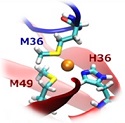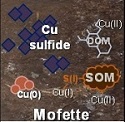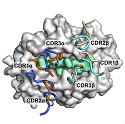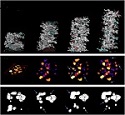Vol. 19, No. 5 - Dec 2018 / Jan 2019
View the Archives

From the Director __________________________________________
My decision to step down as SSRL Director was announced earlier this month. Serving as Director has been a great opportunity that I have embraced with enthusiasm. I have grown personally and professionally as a consequence and I am thankful for the opportunity to lead such an excellent science organization. As Director, I have gained new skill and experience; I have also developed a refined understanding of how I can best serve science. It has been gratifying to play a part in strengthening collaboration across directorates and divisions, supporting research from applied energy programs and battery research to chemistry and catalysis. Guided by this experience, I have chosen to transition to the Chemical Sciences Division Director role at SLAC starting February 1 and look forward to continued interactions with the SSRL community moving forward. Paul McIntyre, the Rick and Melinda Reed Professor at the School of Engineering at Stanford University, has been selected as the next director of SSRL and will begin his appointment on July 1. Paul received his ScD from the Massachusetts Institute of Technology in 1993. He was a postdoctoral fellow at MIT and Los Alamos National Laboratory, and served as a technical staff member at Texas Instruments, Inc., before joining Stanford University in 1997. A professor of Materials Science and Engineering, Paul has served as chair of the Materials Science and Engineering Department since 2014. He is a senior fellow of the Precourt Institute for Energy, and from 2008 to 2013, he served as director of the Geballe Laboratory for Advanced Materials, a Stanford independent laboratory for interdisciplinary materials research. Paul currently leads a research team investigating nanostructured inorganic materials for electronics and energy technologies. A long-time user of SSRL, his expertise and experience will bring new research directions to the lab. Piero Pianetta, Deputy Director of SSRL, will serve as interim director until Paul assumes the directorship in July. Science Highlights _________________________________________
Shared-Ligand Intermediates of Metal Exchange Visualized by Rapid Freeze Quench and Selenium EXAFS of Se-Labeled Metallochaperones. A Paradigm for Studying Copper-Mediated Host-Pathogen Interactions – Contacts: Ninian Blackburn, Oregon Health & Sciences University, and Kelly Chacón, Reed College To defend against infections, our phagocyte cells form a vesicle called a phagosome around pathogens, which then merges with a lysosome to form a phagolysosome. To terminate the threat, the phagolysosome gives the invading cell toxic doses of copper. However, some bacteria have evolved mechanisms for pumping the copper back out of the cell, avoiding toxicity. Understanding the enzymes involved in these complicated processes is important to our understanding of disease. Read more...
Copper Mobilization and Immobilization along an Organic Matter and Redox Gradient – Insights from a Mofette Site – Contacts: Britta Planer-Friedrich and Judith Mehlhorn, Bayreuth University, Germany While a small amount of copper is essential for living organisms, too much copper contaminating our soils can be toxic and pose a serious problem. Copper has an affinity for organic matter in soils, where it mainly exists in the two redox states Cu(I) and Cu(II). In soils that fluctuate in redox conditions, the mobility of copper through the environment can be hard to predict. Mofette sites, produced by CO2 degassing usually found in seismically active areas, are good natural laboratories due to their wide range of soil redox conditions and of soil organic matter composition within a small area. Near the sites of CO2 degassing, the soil is anoxic and organic matter does not decompose well. The soils transition to oxic conditions just a few meters away. A team of researchers studied the behavior of copper in the natural gradient of a mofette site in the Czech Republic. Read more...
A Structural Switch that Couples TCR Ligand Binding to Signaling – Contacts: Chris Garcia and Leah Sibener, Stanford University T cells allow our immune system to respond to specific antigens from infectious agents. Each T cell hosts a receptor (TCR) that binds to a particular antigenic peptide ligand. If the receptor is exposed to the ligand it recognizes, the T cell is activated. A team of researchers used a variety of methodologies including protein engineering, x-ray crystallography, single molecule techniques, and molecular simulations to understand how T cells recognize their ligands and subsequently how T cells are activated. Read more...
Evolution of the Nanoporous Structure of Sintered Ag at High Temperature Using in-Situ X-ray Nanotomography – Contacts: Yijin Liu, SSRL and Xavier Milhet, Institut Pprime, France Many new electronic devices replace traditional silicon chips with silicon carbide (SiC) semiconductor chips, which are able to handle more power, function with less power loss, and operate at higher temperatures. Because these chips generate more heat, new materials that bond the chip to the heat sink are needed. A promising choice is sintered silver (Ag). However, detailed and quantitative information about the pore structure and evolution during aging of sintered Ag have not been well studied. A team of researchers quantitatively analyzed the pore structure of sintered silver at high temperatures over time. Read more... SSRL-Related News ________________________________________Study Shows Single Atoms can Make More Efficient Catalysts Excerpt from January 7, 2019 SLAC News Feature article by Glennda Chui Catalysts are chemical matchmakers: They bring other chemicals close together, increasing the chance that they’ll react with each other and produce something people want, like fuel or fertilizer. Since some of the best catalyst materials are also quite expensive, like the platinum in a car’s catalytic converter, scientists have been looking for ways to shrink the amount they have to use. Using four approaches – infrared spectroscopy, electron microscopy, theoretical calculations and x-ray spectroscopy on Beam Line 6-2 at SSRL scientists now have their first direct, detailed look at how a single atom catalyzes a chemical reaction. The reaction is the same one that strips poisonous carbon monoxide out of car exhaust, and individual atoms of iridium did the job up to 25 times more efficiently than the iridium nanoparticles containing 50 to 100 atoms that are used today. The research team, led by Ayman M. Karim of Virginia Tech, reported the results in Nature Catalysis. Read more... SSRL Users' Executive Committee Update _______________________UEC Election Results Please join us in supporting Graham George and Timothy Stemmler as the new Chair and Vice-Chair of the Users' Executive Committee. We are pleased to welcome new members Michael Capano, Bor-Rong Chen, Amy Cordones-Hahn, and Arianna Gleason (Ex Officio, LCLS UEC). We would like to acknowledge the contributions of David Bushnell (2018 Chair) and the entire UEC in support of SSRL this past year and extend our thanks to retiring committee members Feng Lin, Lisa Mayhew, Mariano Trigo and Christoph Bostedt (Ex Officio, LCLS Past Chair). And, we would like to express our appreciation to Eddie Snell and James P. Evans who will remain on the committee after standing for election. Upcoming Events and Courses ________________________________SSRL Resonant Inelastic X-ray Scattering with Hard X-rays Workshop February 20-22, 2019 SSRL will conduct a Resonant Inelastic X-ray Scattering with Hard X-rays workshop between February 20 and February 22. The three-day session will include lectures and tutorials on hard x-ray RIXS with focus on experimental details and in-depth data analysis and interpretation methods using both experimental fingerprints and detailed theoretical descriptions. Examples will be highlighted in various scientific fields. Advanced registration is required by February 15. workshop website U.S. Particle Accelerator School June 17-28, 2019 The next program of the university-style credit courses will be sponsored by the University of New Mexico to be held in Albuquerque, New Mexico on June 17-28, 2019. website Joint SSRL/LCLS Users’ Conference September 25-27, 2019 – Call for Workshop Topics by March 18 We are beginning to plan for the next joint SSRL/LCLS Users' Conference to be held here at SLAC September 25-27, 2019, and we need your input! Please send us suggestions for full or half-day workshop topics for the conference. Include a working title, brief description of the science area or topics that could be discussed, and potential organizers. We would also appreciate your suggestions for keynote talks or potential speakers. Please contact SSRL UEC members or the User Office to share your input. EMSL Integration 2019 – Plants, Soil and Aerosols: Interactions that tell stories of Ecosystems, Climate and National Security” October 8-10, 2019 announcement Announcements __________________________________________New Instrument at LCLS for MeV-Electron Diffraction for Ultrafast Science Applications (MeV-UED) Since 2014, the UED instrument team has been developing robust methods in the pursuit of time-resolved measurements to control and understand molecular structural dynamics and the coupling of electronic and nuclear motions in a variety of material and chemical systems. MeV-UED’s first external user experimental time on the Solid State (Materials) & Warm Dense Matter (Single Shot) Endstation has been announced for mid 2019. MeV-UED Instrument Page A virtual MeV-UED meeting (webcast) will be held Tuesday, February 19 at 8:30 am to inform the community about developments at MeV-UED before the upcoming MeV-UED proposal deadline on March 12. For more information on MeV-UED, please contact the instrument experimental points of contact: Xiaozhe Shen, Alex Reid, and Ming-Fu Lin User Research Administration _______________________________Beam Time Request Deadline
SSRL Proposal Deadlines
See SSRL Proposal & Scheduling Guidelines and submit proposals and beam time requests through the User Portal.
New Mothering Pod near Experimental Floor At the request of several users, we have created a dedicated mothering room at SSRL. This new Mamava pod is located next to BL9-2 behind the user kitchen/lounge. _____________________________________________________________________ The Stanford Synchrotron Radiation Lightsource (SSRL) is a third-generation light source producing extremely bright x-rays for basic and applied research. SSRL attracts and supports scientists from around the world who use its state-of-the-art capabilities to make discoveries that benefit society. SSRL, a U.S. DOE Office of Science national user facility, is a Directorate of SLAC National Accelerator Laboratory, operated by Stanford University for the U.S. Department of Energy Office of Science. The SSRL Structural Molecular Biology Program is supported by the DOE Office of Biological and Environmental Research, and by the National Institutes of Health, National Institute of General Medical Sciences. For more information about SSRL science, operations and schedules, visit http://www-ssrl.slac.stanford.edu. To unsubscribe from SSRL Headlines, just send an e-mail to listserv@slac.stanford.edu with "signoff ssrl-headlines" in the body. To subscribe, send an e-mail to listserv@slac.stanford.edu with "subscribe ssrl-headlines" in the body. Questions? Comments? Contact Lisa Dunn
|






